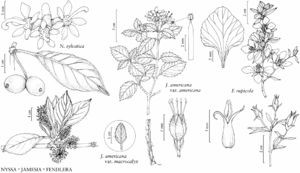Nyssa
Sp. Pl. 2: 1058. 1753.
| Taxon | Illustrator ⠉ | |
|---|---|---|
 | Nyssa sylvatica Fendlera rupicola Jamesia americana var. macrocalyx Jamesia americana var. americana | Yevonn Wilson-Ramsey Yevonn Wilson-Ramsey Yevonn Wilson-Ramsey Yevonn Wilson-Ramsey |
Shrubs or trees; bark gray brown, rough, ridged; twigs with transverse diaphragms; winter buds scaly. Leaves: petiole terete or winged; blade usually elliptic to oblanceolate or obovate, rarely ovate, base cuneate to rounded. Pedicels: staminate present or absent, bisexual and pistillate absent [present]. Flowers: sepals forming a low rim; petals greenish to greenish white; style subulate or conic. Drupes usually blue-black (sometimes reddish purple in N. aquatica; yellow, orange, or red in N. ogeche), topped by persistent remnants of sepals; mesocarp juicy, acidic.
Distribution
c, e North America, Mexico, Central America (Costa Rica), Central America (Panama), e Asia
Discussion
Species ca. 13 (5 in the flora).
Plant sexuality in Nyssa is complicated and often difficult to determine. R. E. Burckhalter (1992) described all North American species as dioecious, without elaboration. The most widely distributed species in the flora area, N. sylvatica, has both staminate and morphologically bisexual flowers and appears to be androdioecious, but is functionally dioecious, as anthers of bisexual flowers do not dehisce (R. H. Eyde 1963; M. L. Cipollini and E. W. Stiles 1991). Similarly, the Chinese N. yunnanensis W. Q. Yin ex H. N. Qin & Phengklai appears to be androdioecious but is functionally dioecious; in this case pollen from the morphologically bisexual flowers is inaperturate and inviable, rendering the trees that bear these flowers functionally pistillate (Sun B.-L. et al. 2009). Nyssa ogeche appears to be polygamodioecious and other North American species appear to be monoecious or polygamomonoecious, but their reproductive biology has not been examined carefully.
Measurements of leaves refer to fully expanded ones from mid shoot (earlier leaves typically are smaller).
Selected References
Lower Taxa
Key
| 1 | Drupes 22–28 mm; ovaries hairy; staminate pedicels absent. | > 2 |
| 2 | Petioles 30–60 mm; drupes punctate, black to blue or reddish purple. | Nyssa aquatica |
| 2 | Petioles 6–20(–35) mm; drupes smooth, yellow, orange, or red. | Nyssa ogeche |
| 1 | Drupes 7–14 mm; ovaries glabrous; staminate pedicels present. | > 3 |
| 3 | Shrubs or trees, 2–5 m; Florida panhandle region. | Nyssa ursina |
| 3 | Trees, 5–30 m; widespread in c, e North America, including Florida. | > 4 |
| 4 | Leaf blades herbaceous, obovate to elliptic, apices acute to acuminate, margins entire proximally and 0–1(–3)-toothed distally; bark ± regularly longitudinally and transversely fissured; pistillate and bisexual inflorescences (2–)3–5(–8)-flowered. | Nyssa sylvatica |
| 4 | Leaf blades subcoriaceous, usually oblanceolate to narrowly elliptic, rarely ovate, apices obtuse to acute, margins usually entire, rarely coarsely dentate distally; bark irregularly fissured; pistillate and bisexual inflorescences 1–3-flowered. | Nyssa biflora |